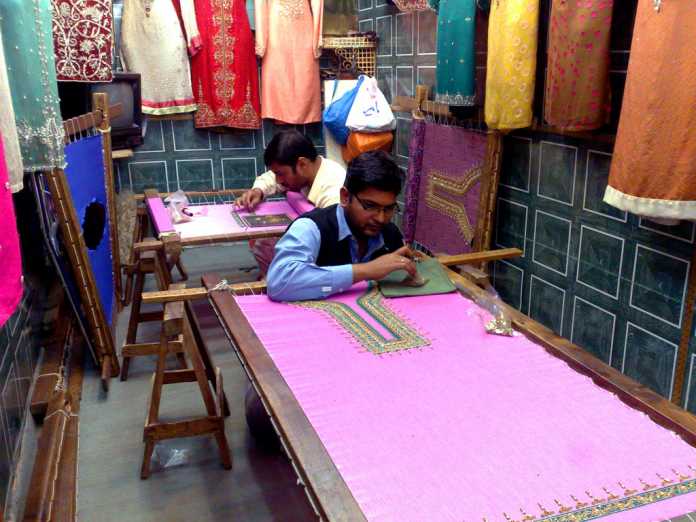Whether you buy your Indian clothes at a multi-designer boutique or source fabric at your local market to have stitched by a trusted tailor, chances are you have spent a pretty penny on your ‘Indian’ clothes.
10,000 rupees for the average person is a fair amount of money- it could be your petrol bill for the month, your phone bill for a couple of months, or a round-trip ticket to Goa for the weekend. Yet when purchasing Indian clothes, 10,000 rupees could not fetch you a whole lot.
Fabrics by the meter can be surprisingly affordable, same for raw materials such as sequins, beading and lace. Even the labour costs for tailors and karigars is a humble amount considering the hours they spend stitching and beading. However, the price tags on garments are usually exorbitant. Of course, there are added costs for branding, marketing, original design and overall retail experience. When a garment is unique and the cost-per-wear reasonable, such price tags can be justified.
It isn’t possible for a majority of the customers to gauge whether or not a design is original. Luckily for some and unfortunately for others, digital fashion police agencies are able to comb through the buckets of content splashed online in order to bring awareness to potential buyers.
It starts at the top
Many A-list designers like Sabyasachi, Anita Dongre and Manish Malhotra have set up businesses in a way that not only brings employment opportunities in communities where it’s needed but also helps keep traditional crafts alive. The hefty tags on their garments can be sometimes justified for the cost per wear they provide and for the beauty of the clothes they make.
Aside from aesthetics, these designers are also starting to create avenues for karigars to shine, even if there is a long way to go. Manish Malhotra’s annual Mijwan collection has helped the small town in Uttar Pradesh develop and make significant advancements year after year. With Grassroot, Anita Dongre has provided economic empowerment to groups of rural women. Not only has she been able to connect these women with SEWA( Self Employed Women’s Association) but she has also introduced a sustainable way of preserving local craftsmanship. She was also one of the first A-list designers to showcase photographs of real women and artisans alongside models on the walls of her stores. This simple gesture goes a long way in creating recognition.
Similarly, with constantly including traditional fabrics and elements in his design portfolio, Sabyasachi has not only help keep traditional design relevant, he has found it a way to make dying traditional elements desirable and even aspirational.
Even with the revival taking place in pockets, ‘karigars’ as a community, and karigari as a trade are on the verge of decline. The art of embroidery, jewellery design and stone setting all fall under the umbrella of karigari. In many families, this is a skill passed on to new generations from their ancestors.
The first step to success is recognition and that is a key element that lacks in this trade. Even people uninterested in fashion will recognize the names of top designers, but few will recognize companies like Chanakya International and Aamir Ltd. Major fashion houses from Europe and the rest of the globe outsource their beading and embroidery to companies like these, who provide employment to hundreds of skilled workers. Indian karigari isn’t just a part of Indian clothing, it is a part of the fashion industry on a global scale.
Skilled and unskilled
There are many forms of education taking place in our country. Sometimes the education provided in the schools of villages may not seem at par with the schools in the cities. However, the skill of karigari passed down from generation to generation in the heartland of India can be so a rare talent that it can’t be acquired anywhere else.
Many fashion institutes offer courses on designing, but a few offer courses on karigari, because aspiring designers are trained to outsource this skill. It can be argued that it is logistically impossible for a designer to sketch, source and put an entire outfit together especially when they have collections to create.
In the ecosystem of Indian clothes, there is a lot of workload to be shared by many, but the recognition for that work lies with a few. It’s important to know who the best karigars are, where they come from and what the cultural significance of their work is.
When we give karigars the compensation and recognition they deserve, more young people will be drawn into this trade rather than born into it. As one of the youngest populations in the world, we are grappling with overpopulation and the need to expand employment options is profound.
A restructure in this industry by way of improving benefits for karigars can revive this trade and draw more people to it. This applies for the jewellery industry as well, where the majority of production falls in the hands of karigars.
Currently, there are an approximate 50 lakh young people working as domestic help, many prefer to work as security guards and drivers instead of being craftsmen. There is dignity in preserving our heritage, but the compensation is missing.
From institutes and colleges, to media reception, and design houses, at every level we need to re-look at the art and craft of karigari so that a whole new generation is inspired to not just design but also to create.





























